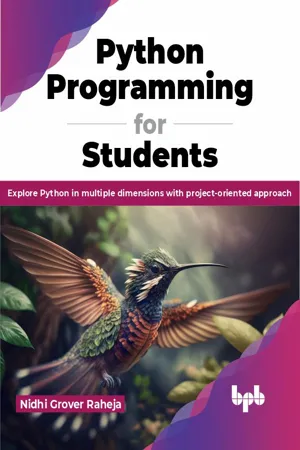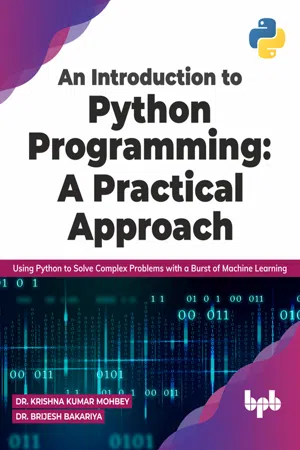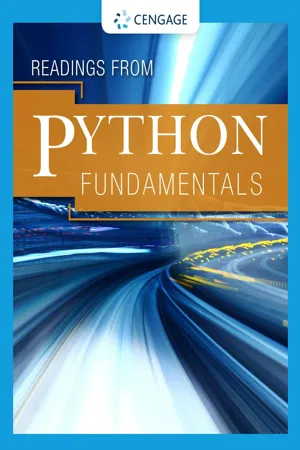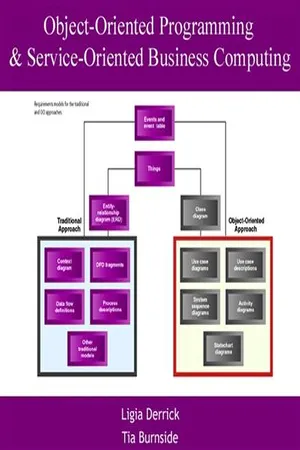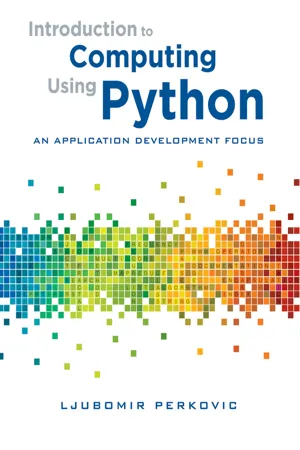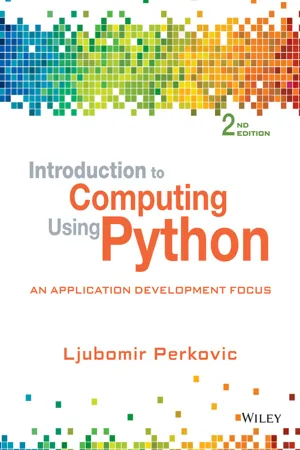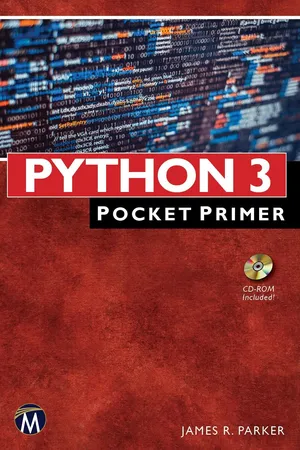Computer Science
Classes in Python
Classes in Python are a fundamental part of object-oriented programming. They serve as blueprints for creating objects, allowing for the encapsulation of data and functionality. By defining attributes and methods within a class, developers can create reusable and organized code. In Python, classes enable the implementation of inheritance, polymorphism, and encapsulation, facilitating the creation of complex and modular software systems.
Written by Perlego with AI-assistance
Related key terms
1 of 5
11 Key excerpts on "Classes in Python"
- eBook - ePub
Python Programming for Students
Explore Python in multiple dimensions with project-oriented approach (English Edition)
- Nidhi Grover Raheja(Author)
- 2023(Publication Date)
- BPB Publications(Publisher)
A Class serves as a user-defined blueprint or template from which objects can be created. The class offers a way to group together functionality and data in a single unit. It contains the state (attribute) and action (behavior) of the object. Here, the state represents data variables, and the methods represent actions that enable modifying the state. In order to use class, we are required to instantiate it by creating its instances called Objects. Thus, we may define an object as an entity with a state and actions. An object has access to the data and methods of its class. As there is no limit on the number of class objects, we may create any number of objects for a class. Figure 5.3 shows modeling real-world problems into classes and objects: Figure 5.3: Modelling real-world problems into classes and objects The following is the syntax for creating a new class: class Class_Name: '''Optional class documentation string''' # class body or suite objName = Class_Name() Here, the keyword class followed by the class name is used to create a new class in Python. The docstrings are optional strings that serve as our code’s description and can be accessed via ClassName.__doc__ attribute. The class suite refers to the set of attributes and methods in the class. A new object objName can be created by simply calling the class name with parenthesis. Class attributes and methods A class encapsulates or binds together the data members (attributes) and methods that use these data members together in one unit. In Python, there exist different types of attributes and methods in a class. The two types of data members or variables that can be used in a class are as follows: Class variable: A class variable is the one that is shared by all instances of a class. These variables are defined within a class body but are present outside any of the class’s methods - eBook - ePub
An Introduction to Python Programming: A Practical Approach
step-by-step approach to Python programming with machine learning fundamental and theoretical principles.
- Dr. Krishna Kumar Mohbey; Dr. Brijesh Bakariya(Author)
- 2021(Publication Date)
- BPB Publications(Publisher)
Python, like other general-purpose programming languages, has been an object-oriented language. It enables us to build applications in an object-oriented manner. We can easily develop and use classes and objects in Python. Using classes and objects to construct the software is an object-oriented paradigm. The object is linked to real-world objects such as a computer, a home, a mobile, etc. The OOPS definition emphasizes the development of reusable code. It is a common method of resolving a problem by creating objects. The following are the key concepts of an object-oriented programming paradigm:- Class
- Object
- Method
- Data Abstraction and Encapsulation
- Inheritance
- Polymorphism
Introduction to classes
A set of objects can be described as a class. It's a logical entity with some unique properties and methods. For instance, if you have a student class, it should have an attribute and a method, such as name, age, address, and course.Object
The object is a self-contained entity with state and actions. It could be a laptop, a purse, a phone, a table, a pencil, or something else. In Python, everything is an object, with attributes and methods on almost everything. A class must construct an object to assign memory when it is defined.Method
In Python, a method is like a function, except that it is linked to objects and classes. Except for two big variations, Python methods and functions are similar.- For the object for which it is named, the method is used implicitly.
- Data in the class is accessible to the method.
Data abstraction and encapsulation
In object-oriented programming, encapsulation is also essential. It's used to limit access to variables and methods. Encapsulation protects code and data from accidental modification by wrapping them together in a single device.Abstraction is a technique for hiding internal information and displaying only the functionalities. The term abstract - No longer available |Learn more
- (Author)
- 2014(Publication Date)
- Learning Press(Publisher)
________________________ WORLD TECHNOLOGIES ________________________ Chapter 3 Class and Instance (Computer Science) Class (computer science) In object-oriented programming, a class is a construct that is used as a blueprint (or template) to create objects of that class. This blueprint describes the state and behavior that the objects of the class all share. An object of a given class is called an instance of the class. The class that contains (and was used to create) that instance can be considered as the type of that object, e.g. an object instance of the Fruit class would be of the type Fruit. A class usually represents a noun, such as a person, place or (possibly quite abstract) thing - it is a model of a concept within a computer program. Fundamentally, it encapsulates the state and behavior of the concept it represents. It encapsulates state through data placeholders called attributes (or member variables or instance variables ); it encapsulates behavior through reusable sections of code called methods . More technically, a class is a cohesive package that consists of a particular kind of metadata. A class has both an interface and a structure. The interface describes how to interact with the class and its instances using methods, while the structure describes how the data is partitioned into attributes within an instance. A class may also have a representation (metaobject) at run time, which provides run time support for manipulating the class-related metadata. In object-oriented design, a class is the most specific type of an object in relation to a specific layer. Programming languages that support classes subtly differ in their support for various class-related features. Most support various forms of class inheritance. Many languages also support features providing encapsulation, such as access specifiers. Reasons for using classes Computer programs usually model aspects of some real or abstract world (the Domain). - eBook - PDF
- Cengage, Cengage Cengage(Authors)
- 2020(Publication Date)
- Cengage Learning EMEA(Publisher)
With the benefits it confers, OOP is a powerful tool in a programmer’s tool box. In the next lesson, we will be looking at how OOP is used in Python. LESSON 7.2 OOP IN PYTHON Classes are a fundamental building block of object-oriented programming. They can be likened to blueprints for an object, as they define what properties and methods/behaviors an object should have. For example, when building a house, you would follow a blueprint that tells you things such as how many rooms the house has, where the rooms are positioned relative to one another, or how the plumbing and electrical circuitry is laid out. In OOP, this building blueprint would be the class, while the house would be the instance/ object. In the earlier modules, we mentioned that everything in Python is an object. Every data type and data structure you have encountered thus far, from lists and strings to integers, functions, and others, are objects. This is why when we run the type function on any object, it will have output similar to that shown in Snippet 7.1. Copyright 2020 Cengage Learning. All Rights Reserved. May not be copied, scanned, or duplicated, in whole or in part. Due to electronic rights, some third party content may be suppressed from the eBook and/or eChapter(s). Editorial review has deemed that any suppressed content does not materially affect the overall learning experience. Cengage Learning reserves the right to remove additional content at any time if subsequent rights restrictions require it. Module 7 object-oriented PrograMMing 99 You will note that calling the type function on each object prints out that it is an instance of a specific class. Lists are instances of the list class, strings are instances of the str class, dictionaries are instances of the dict class, and so on and so forth. - No longer available |Learn more
- (Author)
- 2014(Publication Date)
- College Publishing House(Publisher)
________________________ WORLD TECHNOLOGIES ________________________ Chapter 3 Class and Instance (Computer Science) Class (computer science) In object-oriented programming, a class is a construct that is used as a blueprint (or template) to create objects of that class. This blueprint describes the state and behavior that the objects of the class all share. An object of a given class is called an instance of the class. The class that contains (and was used to create) that instance can be considered as the type of that object, e.g. an object instance of the Fruit class would be of the type Fruit. A class usually represents a noun, such as a person, place or (possibly quite abstract) thing - it is a model of a concept within a computer program. Fundamentally, it enca-psulates the state and behavior of the concept it represents. It encapsulates state through data placeholders called attributes (or member variables or instance variables ); it encapsulates behavior through reusable sections of code called methods . More technically, a class is a cohesive package that consists of a particular kind of metadata. A class has both an interface and a structure. The interface describes how to interact with the class and its instances using methods, while the structure describes how the data is partitioned into attributes within an instance. A class may also have a representation (metaobject) at run time, which provides run time support for manipulating the class-related metadata. In object-oriented design, a class is the most specific type of an object in relation to a specific layer. Programming languages that support classes subtly differ in their support for various class-related features. Most support various forms of class inheritance. Many languages also support features providing encapsulation, such as access specifiers. Reasons for using classes Computer programs usually model aspects of some real or abstract world (the Domain). - eBook - PDF
Introduction to Computing Using Python
An Application Development Focus
- Ljubomir Perkovic(Author)
- 2012(Publication Date)
- Wiley(Publisher)
CHAPTER 8 Object-Oriented Programming 8.1 Defining a New Python Class 252 8.2 Examples of User-Defined Classes 260 8.3 Designing New Container Classes 263 8.4 Overloaded Operators 268 8.5 Inheritance 276 8.6 User-Defined Exceptions 284 8.7 Case Study: Indexing and Iterators 287 Chapter Summary 292 Solutions to Practice Problems 293 Exercises 296 Problems 299 THIS CHAPTER DESCRIBES how to implement new Python classes and introduces object-oriented programming (OOP). There are several reasons why programming languages such as Python enable developers to define new classes. Classes that are custom-built for a particular application will make the application program more intuitive and easier to develop, debug, read, and maintain. The ability to create new classes also enables a new approach to structuring application programs. A function exposes to the user its behavior but encapsulates (i.e., hides) its implementation. Similarly, a class exposes to the user the methods that can be applied to objects of the class (i.e., class instances) but encapsulates how the data contained in the objects is stored and how the class methods are implemented. This property of classes is achieved thanks to fine-grained, customized namespaces that are associated with every class and object. OOP is a software development paradigm that achieves modularity and code portability by organizing application programs around components that are classes and objects. 251 252 Chapter 8 Object-Oriented Programming 8.1 Defining a New Python Class We now explain how to define a new class in Python. The first class we develop is the class Point, a class that represents points in the plane or, if you prefer, on a map. More precisely, an object of type Point corresponds to a point in the two-dimensional plane. Recall that each point in the plane can be specified by its x-axis and y-axis coordinates as shown in Figure 8.1. - No longer available |Learn more
Python 3
Pocket Primer
- James R. Parker(Author)
- 2017(Publication Date)
- Mercury Learning and Information(Publisher)
CHAPTER 6CLASSESA class, in the general sense, is a template for something that involves data and operations (functions). An object is an instance of a class, a specific instantiation of the template. Defining a class in Python involves specifying a class name and a collection of variables and functions that will belong to that class. The main class that has been referred to so far has only a few characteristics that we know about for certain.Consider the joke that begins with the phrase “A man walks into a bar”? What is a man, what is a bar, and what does walking entail? Walking seems to be something that a man can do, an action they can perform. And a bar is a place where a man can walk. Can a man do anything else but walk? Is a bar the only place a man can walk to?A man could be a class. It does have a function called walksInto, as one example. A first draft of the man class could be as follows:class man: def walksInto (aBar): # code goes hereIn the above example walksInto is a method; essentially, a method is any function that is part of a class.Classes can have their own data too, which would be variables that “belong” to the class in that they exist inside it. Such variables can be used inside the class but can’t be seen from outside.Looking closely at the simple class man above, notice that it is actually still a rather abstract thing. In the narrative about a man walking into a bar it was a specific man, as indicated by a variable aMan. So it would seem that a class is really a description of something, and that examples or instances should be created in order to make use of that description. This is correct. In fact, many individual instances of any class can be created (instantiated) and assigned to variables. To create a new instance of the class man, the following syntax could be used:aMan = man()When this is done all of the variables used in the definition of man are allocated. In fact, whenever a new man class is created, a special method that is local to man is called to initialize variables. This method is the constructor - eBook - PDF
Introduction to Computing Using Python
An Application Development Focus
- Ljubomir Perkovic(Author)
- 2015(Publication Date)
- Wiley(Publisher)
CHAPTER 8 Object-Oriented Programming 8.1 Defining a New Python Class 240 8.2 Examples of User-Defined Classes 248 8.3 Designing New Container Classes 251 8.4 Overloaded Operators 256 8.5 Inheritance 264 8.6 User-Defined Exceptions 272 Case Study: Indexing and Iterators 275 Chapter Summary 275 Solutions to Practice Problems 276 Exercises 279 Problems 281 THIS CHAPTER DESCRIBES how to implement new Python classes and introduces object-oriented programming (OOP). There are several reasons why programming languages such as Python enable developers to define new classes. Classes that are custom-built for a particular application will make the application program more intuitive and easier to develop, debug, read, and maintain. The ability to create new classes also enables a new approach to structuring application programs. A function exposes to the user its behavior but encapsulates (i.e., hides) its implementation. Similarly, a class exposes to the user the methods that can be applied to objects of the class but encapsulates how the data contained in the objects is stored and how the class methods are implemented. This property of classes is achieved thanks to fine-grained, customized namespaces that are associated with every class and object. OOP is a software development paradigm that achieves modularity and code portability by organizing application programs around components that are classes and objects. 239 240 Chapter 8 Object-Oriented Programming 8.1 Defining a New Python Class We now explain how to define a new class in Python. The first class we develop is the class Point, a class that represents points in the plane or, if you prefer, on a map. More precisely, an object of type Point corresponds to a point in the two-dimensional plane. Recall that each point in the plane can be specified by its x-axis and y-axis coordinates as shown in Figure 8.1. Figure 8.1 A point in the plane. An object of type Point represents a point in the plane. - eBook - ePub
- Kuldeep Singh Kaswan, Jagjit Singh Dhatterwal, B Balamurugan(Authors)
- 2023(Publication Date)
- Chapman and Hall/CRC(Publisher)
Function overloading: The assignment of more than one behavior to a particular function. The operation performed varies by the types of objects (arguments) involved.- Instance variable: A variable that is defined inside a method and belongs only to the current instance of a class.
- Inheritance: The transfer of the characteristics of a class to other classes that are derived from it.
- Instance: An individual object of a certain class. An object obj that belongs to a class Circle, for example, is an instance of the class Circle.
- Method: A special kind of function that is defined in a class definition.
- Object: A unique instance of a data structure that’s defined by its class. An object comprises both data members (class variables and instance variables) and methods.
- Operator overloading: The assignment of more than one function to a particular operator.
11.2 Classes and Objects
A class is essentially a logical entity that serves as a blueprint or blueprints to generate objects, whereas an object is a description of Python functions and variables. Included within the class and accessible utilizing objects are variables and attributes. These mechanisms and quantities are known as attributes [87 ].Let’s take an example for understanding the concept of objects and Classes in Python. One object can be thought of as a normal everyday object, for example, a truck. As already explained, we know the data and functions in a class are described and all these documents and records can be viewed as the characteristics and behavior of the object. That is, the car’s (object’s) features (data) are color, weight, door number and so on. The measurements (features) of the car (object) are rpm, braking and so on. A class, as shown in Figure 11.1 - No longer available |Learn more
Python 3
Pocket Primer
- James R. Parker(Author)
- 2017(Publication Date)
- Mercury Learning and Information(Publisher)
C H A P T E R 6 CLASSES A class, in the general sense, is a template for something that involves data and operations (functions). An object is an instance of a class, a specific instantiation of the template. Defining a class in Python involves specifying a class name and a collection of variables and functions that will belong to that class. The main class that has been referred to so far has only a few characteristics that we know about for certain. Consider the joke that begins with the phrase “A man walks into a bar”? What is a man, what is a bar, and what does walking entail? Walking seems to be something that a man can do, an action they can perform. And a bar is a place where a man can walk. Can a man do anything else but walk? Is a bar the only place a man can walk to? A man could be a class. It does have a function called walksInto, as one example. A first draft of the man class could be as follows: class man: def walksInto (aBar): # code goes here In the above example walksInto is a method; essentially, a method is any function that is part of a class. Classes can have their own data too, which would be variables that “belong” to the class in that they exist inside it. Such variables can be used inside the class but can’t be seen from outside. Looking closely at the simple class man above, notice that it is actually still a rather abstract thing. In the narrative about a man walking into a bar it 112 • PYTHON 3 POCKET PRIMER was a specific man, as indicated by a variable aMan. So it would seem that a class is really a description of something, and that examples or instances should be created in order to make use of that description. This is correct. In fact, many individual instances of any class can be created (instanti- ated) and assigned to variables. To create a new instance of the class man, the following syntax could be used: aMan = man() When this is done all of the variables used in the definition of man are allocated. - eBook - PDF
- Cay S. Horstmann, Rance D. Necaise(Authors)
- 2020(Publication Date)
- Wiley(Publisher)
A programmer provides the desired behavior by specifying and implementing methods for these classes. In this chapter, you will learn how to discover, specify, and implement your own classes, and how to use them in your programs. 9.1 Object-Oriented Programming You have learned how to structure your programs by decomposing tasks into func- tions. This is an excellent practice, but experience shows that it does not go far enough. It is difficult to understand and update a program that consists of a large col- lection of functions. To overcome this problem, computer scientists invented object-oriented programming, a programming style in which tasks are solved by collaborating objects. Each object has its own set of data, together with a set of methods that act upon the data. You have already experienced this programming style when you used strings, lists, and file objects. Each of these objects has a set of methods. For example, you can use the insert or remove methods to operate on list objects. When you develop an object-oriented program, you create your own objects that describe what is important in your application. For example, in a student database you might work with Student and Course objects. Of course, then you must supply methods for these objects. In Python, a class describes a set of objects with the same behavior. For example, the str class describes the behavior of all strings. The class specifies how a string stores its characters, which methods can be used with strings, and how the methods are implemented. A Car class describes passenger vehicles that can carry 4–5 people and a small amount of luggage. © Media Bakery. A class describes a set of objects with the same behavior. 9.1 Object-Oriented Programming 395 You can drive a car by operating the steering wheel and pedals, without knowing how the engine works. Similarly, you use an object through its methods. The implementation is hidden.
Index pages curate the most relevant extracts from our library of academic textbooks. They’ve been created using an in-house natural language model (NLM), each adding context and meaning to key research topics.
